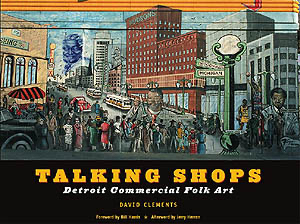Home-Made: Contemporary Russian Folk Artifacts, by Vladimir Arkhipov, Fuel Publishing, 304 pages, 180 color pictures, 2006. ISBN 0-9550061-3-9 Folk Archive: Contemporary Popular Art from the UK, by Jeremy Deller and Alan Kane, Book Works, 158 pages, 2005. ISBN 1 870699-81-5 Two recent books from abroad attempt to document the spontaneous art making of ordinary people, one broadly and one eccentrically. Folk Archives, from Britain, covers a wide range of vernacular expression, from protest posters to shop signs. Home Made, also published in Britain, takes a certain kind of ingenuity as its subject, specifically creative responses to the acute scarcity of
Continue readingCategory: Book Review
Getting Religion on Its Own Terms
Coming Home! Self-Taught Artists, the Bible and the American South, edited by Carol Crown, with essays by Paul Harvey, Erika Doss, Hal Fulmer, Babatunde Lawal, Charles Reagan Wilson and N.J. Girardot, Art Museum of the University of Memphis with the University of Mississippi Press, 215 pages, 122 color plates, other color and b&w illustrations, 2004. ISBN 1-57806-659-X
Stereotypes have two inherent flaws: They often state the obvious and, when too generally applied, they become false. But they also are inescapable because, in the proper context, they are true.
Carol Crown’s exhibition and catalog, Coming Home! Self-Taught Artists, the Bible and the American South, can’t help but draw on Bible Belt stereotypes because they reflect a big slice of Southern reality. There is a lot more substance here than in many folk art theme shows, since the Bible really is the force behind a great deal of self-taught art.
Continue readingBook Review
Authentic Heaven: The Vernacular Art of Urban Spirituality
How the Other Half Worships, by Camilo Jose Vergara, Rutgers University Press, 286 pages, 2005. ISBN 978-0-8135-3682-8 How The Other Half Worships celebrates one of the great engines of true vernacular expression – religion. The subject is inner-city churches, with an emphasis on the storefront variety. Camilo Jose Vergara has spent years visiting and photographing urban churches and their people, fascinated by their architecture and decoration, by what people do in them and by what they do for people. The book is built around his photographs, but it also gives the church folk a direct voice. The generous quotations from
Continue readingThe Last Folk Hero: Collector Bill Arnett’s art world martyrdom
A review of the recent book about Bill Arnett, one of the most important collectors and advocates of self-taught art from the South. Meanwhile, the sad news arrived that Mose Tolliver, one of the best-known southern black artists of the last century, died Monday.
Continue reading
Vernacular Shop Signs
Read a review of David Clements’ wonderful book of hand-painted business signs from Detroit.
Continue reading